If you are looking for a bit of extra inspiration for what to put in your treasure basket then you have come to the right place.
Having used treasure baskets over many years, I have tried out a huge number of ideas, and the very best of those have made the shortlist and got onto this post.
To start with the short answer: what are some of the best treasure basket ideas?
To keep treasure basket play fresh and exciting, you can use different themes to stimulate babies’ senses in multiple ways. Some of these include black and white objects, wood or metal objects, noisy items, objects that smell, or things that have other interesting properties, like being reflective.
There are a whole load of ideas packed into this one article for you to try out.
If you’re not sure what a treasure basket is, then I would really recommend you check out my essential guide to treasure baskets – what they are and how to use them. This has all sorts of handy tips and hints on how to make them and what they are.
A lot of the ideas coming up are in themes. There are two ways to use these different themes when you create a basket:
- You can add some of the themed objects to basket of other random objects
- You can have a basket of just that theme of objects
Probably in reality a mixture of these two strategies is the way to go.
Anyway, here are the ideas…
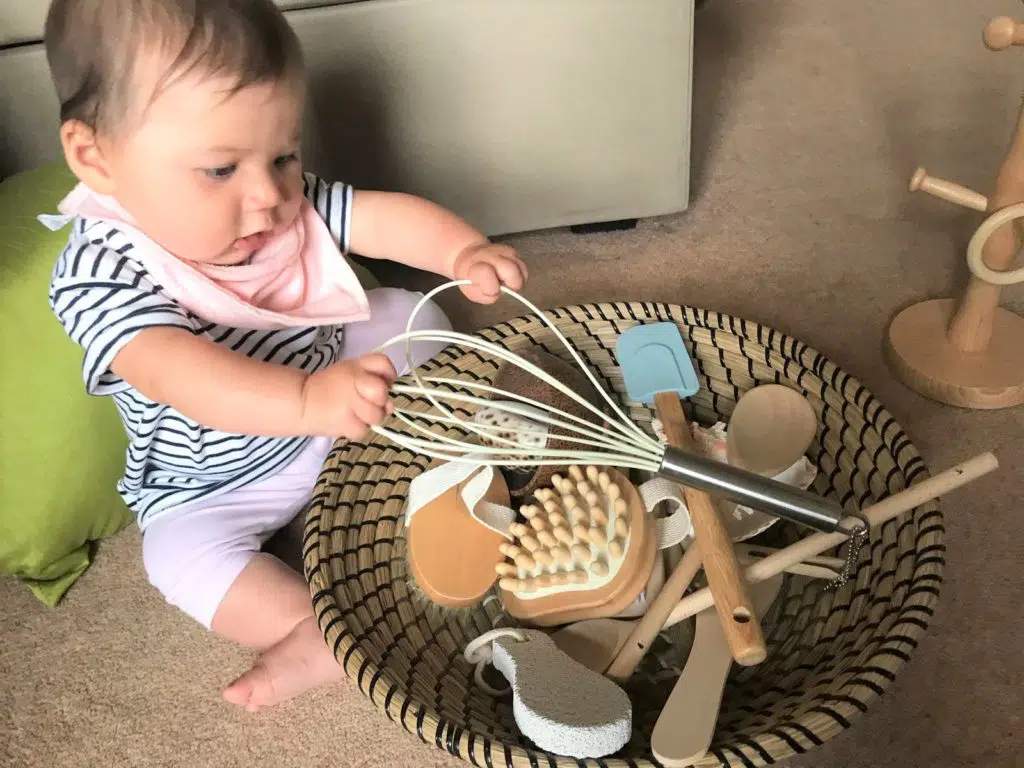
Themed Treasure Basket Ideas
Smells
We often overlook the sense of smell where treasure baskets are concerned, as they seem to often be based around the sense of touch.
But smells can stimulate all sorts of curiosity in children, so they are definitely worth a go!
Some excellent things that you can put into a treasure that smell fantastic include:
- Lemons or limes – These have the added advantage of being really interesting from a texture point of view, and also being brightly colored. They really are truly multisensory.
- Herbs such as rosemary or lavender. Once again they have fascinated textures to go along with the smell. Some herbs also have calming properties, lavender being an example
- Grapefruit – The provide a similar learning experience to lemons and limes
- Small bag of petals – These can be really fragrant and will really engage and stimulate your child’s senses
Stimulating a baby’s senses is just one of the ways in which treasure baskets are really effective. I have written an article all about the 16 benefits of using treasure baskets with babies, that you can read here.
Black And White
It takes a long time for babies to fully ‘see’ and understand color. There world begins as a black and white one, and over time the colors begin to develop.
Babies are really stimulated by the contrast between black and white, so why not add only these colors to a treasure basket? Some great items include:
- Leather gloves
- Small bags (either white or black)
- Scarves
- Small pieces of material
- Belts
- Socks
Noisy Objects
Sound is really stimulating for young children. It develops their early listening and attention skills, laying the foundations for communication and even phonics later on. If you are interested in what kind of games young children can play to develop their listening and attention skills in particular then check these out.
Noisy objects are also brilliant for investigating. Children will enjoy manipulating them in different ways to try to create and change the sound they make.
Some great noisy items could include:
- Dog toys
- Small toys with bells in
- Materials like sellophane
- Sweet wrappers
- Keys
What are the 40 best loose parts activities for children? find out
Read the complete practical guide to loose parts play outside.
Reflective Objects
Children are fascinated by mirrors. They loving exploring what objects look like if you put them next to them. They also like to look at themselves, or see the world around them reflected in the mirror.
They are also really interested in any surface that acts a bit like a mirror; this really sparks their curiosity.
Some great examples of reflective objects that you can use in a treasure basket include:
- Safety mirrors
- Pocket mirrors for make-up
- Shiny spoons
- Silver bowls or dishes
- Ladels
- Metal cups
Many of these objects are also excellent in heuristic play. To find out the many benefits of this type of play then you can go here.
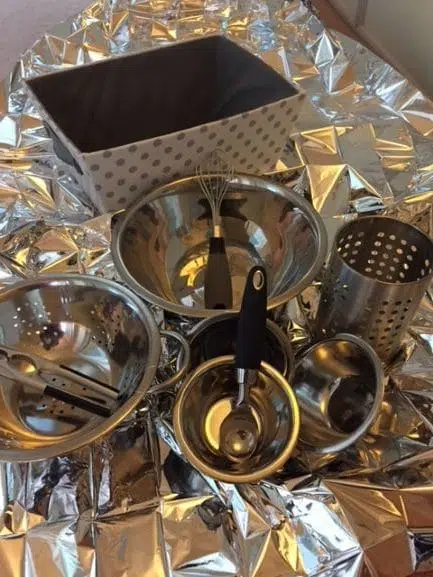
Wooden Objects
Picking one type of material for the treasure basket is another interesting way of creating one.
One good example would be wooden objects. Natural objects will normally have a more stimulating texture to them. They may be rough, strangely patterned, smooth, undulating – the list goes on and on.
Wooden objects are also really versatile. Some will be entirely natural, and some will have been crafted into different things by humans. Some great wooden things to put in a treasure basket include:
- Wooden spoons
- Small sticks
- Plates or bowls
- Egg cups
- A building block
- Shapes, either 2D or 3D
Just see what you have lying around the house!
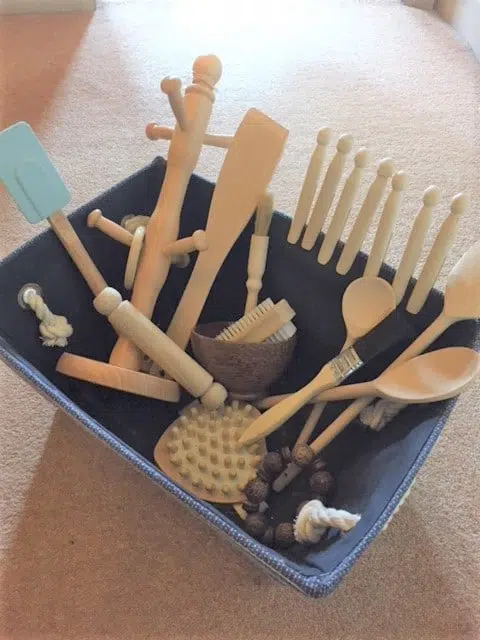
Color
Colors play a big role in developing children’s sense of sight, and also really spark their curiosity.
It is a good idea to pick a bright color, for example something like red, and create a treasure basket with items of just this color.
This will provide a huge amount of visual stimulation, as well as there being lots of different objects in there for them to explore the textures, weights, and other properties as well.
Some good examples of things all the same color might be:
- A red apple
- A red ball
- A dog toy
- A red comb
- A red scarf
These, of course, are just a few random examples. Just have a scout around and see what you can find! If you’re struggling for red, then try blue or green or yellow. The color is not important – it is just getting a few objects quickly that is the key to it.
Treasure basket play should not take too long to prepare for! If it does, the adult can start to find it an onerous task, and this really is not what it should be about. Just find whatever you can in your house and stick it in. Also the beauty of treasure basket play is that you can repeat it with the same objects, often many times.
Treasure basket play develops into loose parts play later on. To find out the many benefits of loose parts play, then check this out.
Soft Objects
Items that are soft have lots of potential to spark curiosity and enquiry.
Children are able to bend them in different ways. They can lift them, drop them, put one over the other, envelop objects (i.e. put something around them), and just do so many more things!
Your house is doubtless full of soft objects anyway that you can select from, so why not have a go of trying a few of the following items:
- Gloves
- Silk scarves
- Wool
- Felt
- Hair scrunchies
- Baby clothes
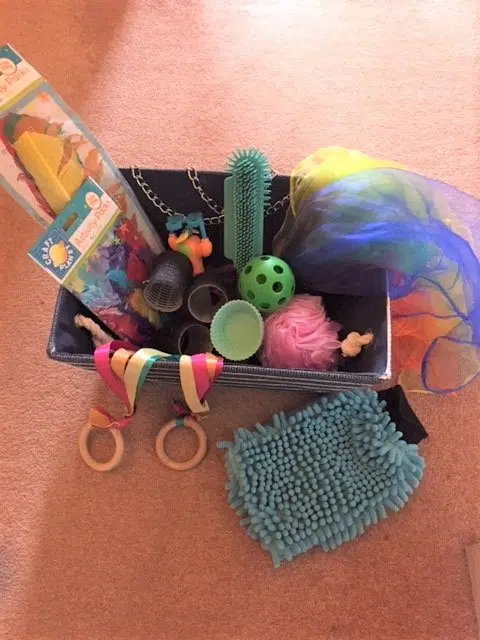
Kitchen
This is a great idea if you are trying to put a treasure basket together in world-record time! In reality, this may well happen. It is one thing to see baskets on Instagram that have been carefully arranged to make the perfect picture, but quite another thing to deliver treasure basket play in the real world, with so many pressures on our time.
If you want to look for one room where you can quickly compile a high-quality treasure basket in under a minute, that room is definitely the kitchen.
There is a such a large array of different materials, sizes of items, and just loads of things that have interesting properties such as being shiny or rough.
Some great ideas for things might be:
- A large whisk (one where they cannot get their fingers stuck)
- Small pots/pans
- Ladels
- Slotted spoons
- Cutlery (not knives)
- Sieves
- Small colander
Instruments
Instruments for treasure baskets are another item that of course stimulates hearing. Once again this is great for developing attention skills, and developing communication.
Children need to discriminate and understand sounds to be able to speak, listen and later read.
Instruments could be baby instruments, or they could be small adult instruments (like bells). Just don’t use anything too big or heavy, or any they could get their fingers stuck in.
Instruments in one part are the best. For example, bells are good because you just need to shake them. Drums are much trickier at this age, because they come in two parts (a drum and a stick). This quite hard for children to coordinate at this age. Some examples could be:
- Tambourines
- Sleigh bells
- Mini ‘church bells’
- Marracas
- Shakers
- Rainsticks
To find out some other simple instrument games to play with young children, then why not check out these 11 parachute games for music.
Balls
Balls come in all sorts of shapes, sizes, textures and materials!
If you already have a range of different balls lying around your house, then they could be a great addition to a treasure basket, either mixed in with other objects, or just a selection all by themselves.
Here are some different types of balls you might be able to find:
- Rubber balls – bouncy balls (but not too small so they can eat them), racketball balls, larger baby balls
- Ping pong balls (these are really interesting because they are so light)
- Tennis balls
- Golf balls
- Sponge balls
- Wooden balls
Rough And Smooth
Often it is a great idea to get some real contrast into the treasure basket. This really sparks interest as one item is so different from another.
Rough and smooth objects are really easy to find, and also offer many opportunities to explore through touch.
Some great rough objects might be:
- A scourer
- Pinecones
- Shells
- Sponge
- Sandpaper
- Old piece of sacking
On the other hand some great smooth objects could include:
- Pebbles
- Conkers
- Velvet
- Hard boiled egg
Light And Heavy
Another great contrast is to select some items based on their different weights. The important thing is to not include anything too heavy. This could be dangerous if children hurt themselves picking it up, and dropping it.
Some great examples of light things could be things like:
- Feathers
- Silk handkerchief
- Tissue paper
- Cotton wool
- Bubble wrap
Heavier things could be:
- Lumps of wood
- A big orange
- A shoe
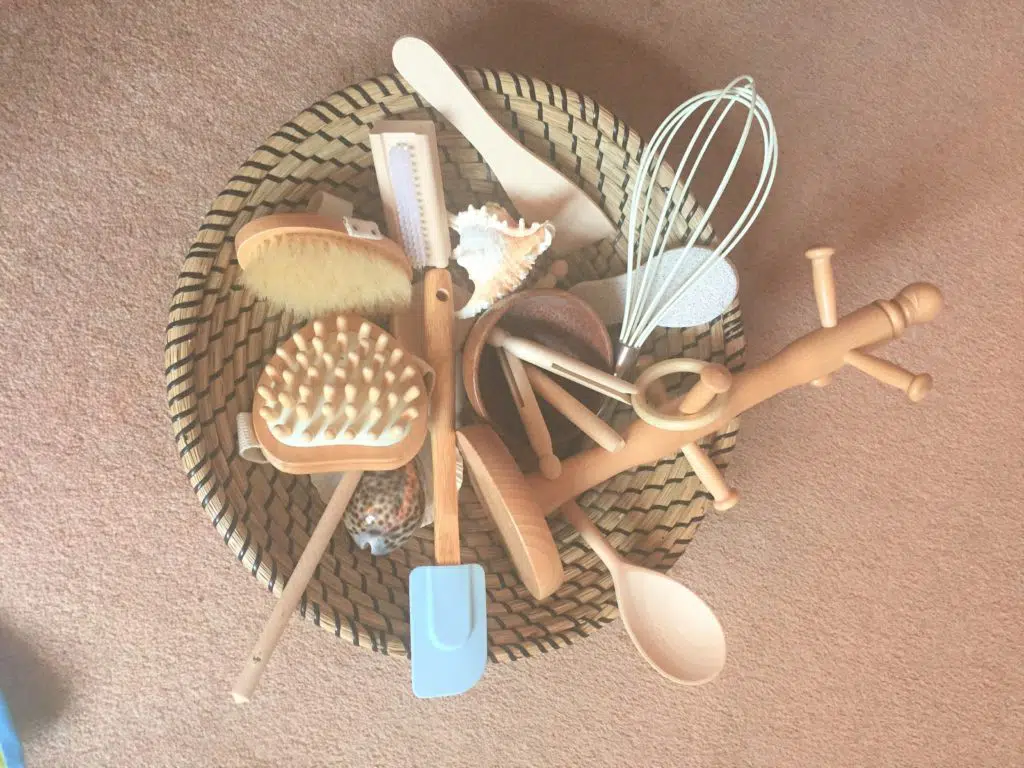
Brushes
Babies find brushes really fascinating, so I thought they deserved a section all to themselves.
There are many different types of brushes around, and they all offer a mixture of textures all in one item – from bristly brush parts, to smooth handles. Here are some brushes you could use:
- House paint brushes
- Hair brushes (or combs)
- Nail brushes – these are excellent because they are so spiky, and have a large surface area or bristles
- Shoe brushes
- Dustpan brush
- Tooth-brush
Metal
Metal offers many interesting properties. It is often quite cold to the touch, which really stimulates the curiosity of babies.
Also it is often shiny, or sometimes fully reflective, and this engages children visually as well.
Metal comes in all sorts of shapes and sizes, including:
- Spoons
- Pots/pans
- Large necklaces
- Ladels/spatulas
- Bowls of different sizes
- Small spanner
- Large bolts
Top Tips For Carrying These Ideas Out
- Select things that have interesting properties – touch, smell, or shape
- Be aware of safety, with the most important thing not to pick any items that babies can get their fingers stuck in, such as small whisks. Also do not pick anything small that they may put in their mouths.
- Use a wicker basket with a heavy base if you have one. To find out the best advice about how to set up effective treasure baket play, then read this.
- You can support your baby with sitting up
- Let them explore! Don’t feel you need to get too heavily involved in the play, or teach them in any way. Research demonstrates the vast importance of allowing children to learn for themselves during this kind of play. (Source)
Next Steps
If you are really passionate about getting started with treasure baskets in the best possible way, then check out our online course ‘Project Loose Parts’. This 2-hour video course is a full step-by-step guide on how to get started with loose parts in the most successful way. It also contains more than a hundred practical ideas. You can check out Project Loose Parts here.
Conclusion
I hope you found these suggestions useful!
You should not have to spend a huge amount of time on money on getting things for treasure basket play. Just finding random items from around your home is the key to it. Also beg, borrow and steal from friends and family!
This article is an extended extract from my book ‘Loose Parts Play – A Beginner’s Guide’. This book provides the ultimate step-by-step sequence to create an outstanding provision of loose parts. It has been read by more than 10,000 people, and you can check the book out on Amazon here.
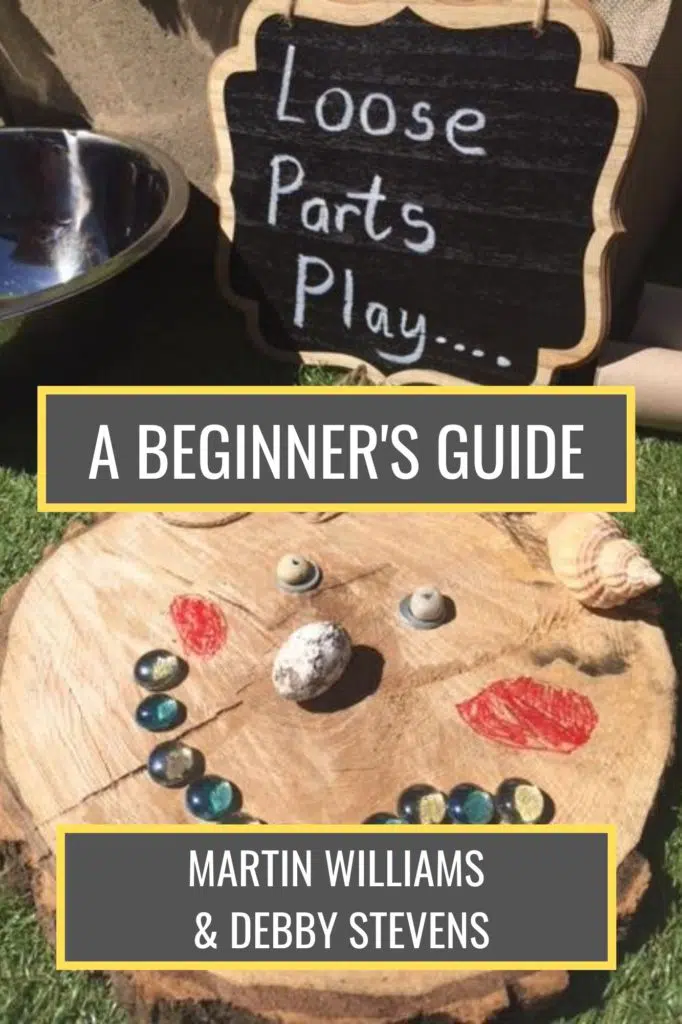
If you’ve found this useful, then why not check out one of these articles:
Loose parts play for babies and toddlers. The definitive guide
